FROM STEPHEN CAMPS WEBSITE
Best Buys In Handguns, Part III: Used/Surplus
By
Aaron Brudenell
Many folks interested in firearms will choose the ones they collect for a number of reasons. Some accumulate products from one gun maker, a specific time or event, or even a single model that may have been copied by numerous manufacturers. Whatever a person’s criteria, most of us will find it hard to resist an obvious bargain even if the item is outside the scope of what we normally fancy. This writer is no exception, in fact, I find myself particularly susceptible to a splendid deal at a gun shop or show. Part of my interest, like many others I’m sure, comes from remembering a time when I was younger and much less able to afford the things I wanted most of all. The big advantage in choosing a highly affordable firearm later in one’s collecting is that you tend to have a greater benefit of experience in spotting a truly useful bargain rather than something that’s just cheap.
Say you have $200 and need a handgun for self-defense. The list of new firearms that can be had at that price isn’t a long one and many of them are of notorious quality and not to be generally trusted for one’s life if there’s a suitable alternative. I found two very good used ones in this price range, and feel sure others exist (both on this site and elsewhere). I was able to obtain the Smith and Wesson K-frame revolver for just under $200 from a retail store specializing in used and surplus firearms. The Makarov pistol was purchased for around $150 from a licensed dealer at a local gun show; however, I’ve noticed prices on this and similar models slowly drift up to and even slightly beyond the $200 mark in the time since. Here’s the first lesson: conspicuous bargains don’t always remain so!
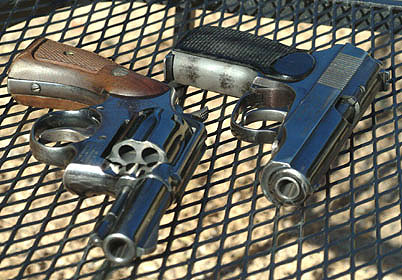
Here is a picture of the 3" Model 10 and the Makarov pistol. Each handgun has its own strong points compared to the other, but both of these do have one thing in common: reliability.
Each of these handguns is a used firearm previously issued to a military or law enforcement agency and that’s a great place to start looking, regardless of how much money you have to hunt for a bargain. The revolver was reportedly one of many issued to a large metropolitan police department in France that probably upgraded to semiautomatic pistols like so many other agencies. Because it was sold abroad and imported back into the US, it bears the dot matrix stamp of the importer. In all other respects, it’s a standard K-frame model 10-5, the standard .38 Special successor to the original Military & Police revolver made before World War two. The only unusual feature is the barrel, which is a tapered 3" version unlike the more common 4" variety.
Makarovs were the main sidearm for many of the Soviet block countries for the latter part of the cold war and were produced by Russia, East Germany, China, and in this case, Bulgaria. East German models are widely considered to be best of all, however, I find the Bulgarian model to be in a close 2nd place! Chinese guns can be of inconsistent quality and I don’t care for the Russian models, which have an adjustable rear sight (an unnecessary addition of size in my view). The exact history of this Bulgarian Makarov is not known, but the double circled "10" indicates it was made in the state run arsenal and these pistols were most likely used by military and police agencies in that country until sometime after the fall of the iron curtain. As with the revolver, this handgun was imported and bears a similar dot matrix identifier of the importer (the same one as it turns out).
When comparing this pair of options, more differences exist than the usual "revolver" versus "semiautomatic" debate but first I’d like to consider the commonalties. Both handguns have numerous grip options available and this is very important if one is to select a handgun for their primary defense arm. Most of the Makarov grips are similar in style and shape, however, differences in thickness and texture are significant enough to fit most people’s needs. I chose the East German style of grip because I have small hands and like the texture. Many friends of mine have opted for the soft rubber Pearce grips that fill larger hands and soften recoil. Like any K-frame Smith and Wesson revolver, there is a virtually endless supply of grips available for the model 10 and the mismatched pair of small factory panels suits my needs adequately.
Both the Makarov and Model 10 have outstanding accuracy and reliability to the point I’d be hard pressed to distinguish one in either category. The biggest limitation for each in accuracy is their sights and in both cases, I remain satisfied given their role as a rugged self-defense gun. Because each has both single and double-action capability, they can be carried safely and ready to fire quickly or cocked for more precision shots. Recoil for both is also comparable—standard pressure ammunition for each is mild enough for a novice to master and the +P .38 Specials have the same extra impulse as a few of the heavier recoiling (higher bullet weight) rounds available for the 9x18mm chamber.
Ammunition is the first obvious area of distinction between the two firearms with .38 Special being much more available and diverse in the US than 9x18mm. I often refer to the "Walmart Test" of ammunition availability and clearly you’re more likely to find .38 Specials than 9x18mm wherever you buy your ammunition.
That said, however, the Makarov can be re-barreled quite easily for .380 ACP with minimal cost and I’ve tested several unmodified 9x18mm firearms with .380 ammunition and found surprising reliability with only a slight loss in accuracy. This is not to be considered a recommendation—it’s probably comparable to firing .22 Long Rifle cartridges in a .22 Magnum chamber. Problems with certain short bullet designs and the occasional split case should be expected and I think it’s better to buy a good supply of surplus ammunition for the long term. But in an emergency or if 9x18mm cartridges become rare the Makarov will not become a paperweight. With the pistol in this article, I tested 9 brands of .380 ammunition and only had problems with Winchester Silvertips and some cast reloaded ammunition, both of which had rather short overall lengths.
The Makarov pistol is notably smaller than the revolver and lighter by about 1/3 pound. These are both key features when considering a handgun for concealed carry self defense. The Makarov also has 50% more firepower with a capacity of 8+1, which compares favorably to a six-shooter. Even though the Makarov’s magazine requires a heal release and is slow to reload by modern pistol standards, it’s still quicker than the Smith and Wesson and preloaded magazines are easier to manage than revolver speed loaders and strips. I also find the Makarov to be much more natural to point shoot than the revolver although this ultimately amounts to a personal choice and/or a selection of grips. I come to this conclusion with no lack of experience with Smith and Wesson wheel guns that I’ve owned and used without complaint but for me, with the right grips, the Makarov just fits better.
The Smith & Wesson also has its advantages over the Makarov. For starters, both the double and single- action trigger pulls are lighter and a touch smoother. Additionally, it’s hard to argue with the simplicity of a double-action revolver. The Makarov’s safety is not a bad one: down takes it off while up decocks the hammer and locks the entire action (hammer, trigger, and slide). But with the revolver, as long as the cylinder is fully closed, the gun will function fully with or without ammunition and there are no safeties to forget or worry about. Dry fire practice is always more realistic with a revolver than with a semiautomatic and if firing for effect, the solution to a failure is simply to pull the trigger again. The last and most significant revolver advantage would have to be power.
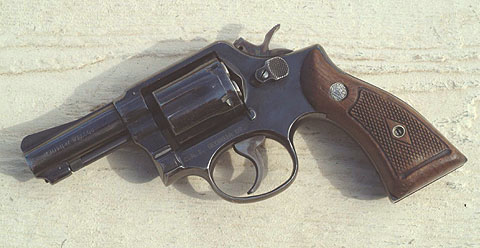
The S&W Model 10 in any of its configurations is a proven design and in a caliber that is probably more potent than the 9x18mm Makarov. Its primary limitations remain but a six-shot capacity and slower reloading.
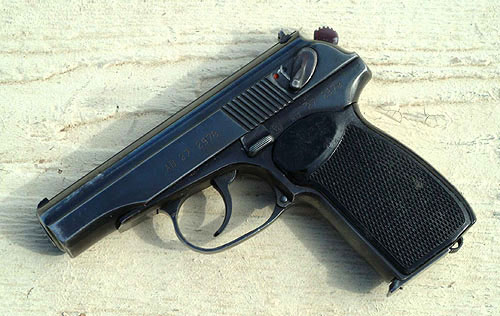
The Makarov holds more shots between reloading than the revolver and despite its magazine release being at the butt of the gun, it is probably quicker than speed strips with the revolver. With speed loaders, the revolver might be just as fast or faster. This would depend upon the skill level of the user. Notice also that even though slide-mounted, the safety on the Makarov works in a natural direction. Down for fire and up for safe.
For self-defense, I’m a big fan of the Speer Gold Dot, which is a good bullet design and in most cases loaded to a healthy power level in factory ammunition. The latest .38 Special + P Gold Dot is a 135 grain bullet that leaves this 3" barrel at around 1000 feet per second. The 9x18mm Gold Dot has the same velocity but is only a 90-grain bullet. Both of these are good options but I would expect the 9x18mm Gold Dot to be less effective by more than a single shade of gray. If one is after heavier weight non-expanding bullets to maximize penetration, good options also exist for both. Fiocchi .38 Special FMJ’s can be had in 158 grain while the Wolf brand 9x18 JHP is available in the 120-125 grain range and doesn’t expand in most media. As with expanding bullets, the edge in the heavier non-expanding projectiles still favors the revolver. (Note: For those interested, there are articles on snub ammunition as well as expansion and comparison tests between 38 Special, 380 ACP and 9x18mm Makarov in "Other Handguns.")
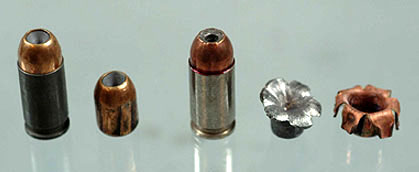
Here are two 9x18mm rounds that were fired into water. The Wolff (left) did not expand while the Silver Bear did. (Bullet and jacket separation is not uncommon when firing into water.)
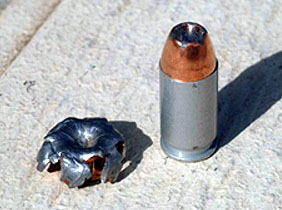
Speer's excellent Gold Dot bullet expands reliably in 9x18mm.
Although both handguns have their respective strong points, neither would leave you inadequately prepared for most uses and for my own purposes, I plan to keep both! The last and final advantage of finding suitable budget guns is that you can avail yourself of more options than you could with less affordable pieces. There are plenty of other affordable used bargains out there and as newer designs replace older ones, one can expect the quality and list of advantages to grow rather than shrink.
....................................................................................................................................................................
End of Days
E-mail me: Click on "View My Complete Profile" or try dovbearbarleib@gmail.com. For Most Recent Post: Click on "End of Days" immediately above.
Thursday, June 14, 2007
And Ya'akov Went on to Sukkot...(Gen. 33.17)
Normally one does not pray for war. Usually in war the righteous in this incarnation of their lives suffer with the wicked. It is a messy business. Those who build networks of chessed institutions suffer with those who plan parades of homosexuals. Those who vote for kindness to their fellow Jews suffer with those who vote for Kadima. At first glance it seems that war is bloody and unfair.Of course, according to Rav Moshe Chaim Luzzato's classic The Way of HaShem, the righteous suffer often to perfect their souls because of sins done or imperfections fostered in previous lives. Sometimes they just suffer for the sins of the generation so that the world itself will not be destroyed by those sins. Be that as it may, War is usually Hell.
The upcoming war that is the final battles of Gog UMagog that will probably take place some time between tomorrow, the 29th of Sivan, and when Gog W. Bush leaves office in January 2009 (Winter 5769) will be no exception to this rule. It will be bloody, lo aleynu, maybe even the bloodiest war in all of history, may Heaven spare us. Yet, the Talmud in several places tells us that in the seventh year there will be war, and when we daven the shmonah esrei (18 blessing prayer), the seventh blessing is a blessing for redemption. Why is this the case?
This is so because the war in the seventh year of Gog UMagog is really the beginning of the redemption process even though Mashiach does not show up until the eighth year. The only question becomes how do we know which year of the eight year process we are in now in the year 5767. The Al Aksa Intifada began a day and a half before Rosh HaShana 5761, and Israel was condemned by the United Nations for defending itself by a vote of 92 to 6 on Hoshana Rabba 5761.
See my article on The South Asian Tsunami . It was the beginning of Israel's agony of the last generation, our Gog and Magog agony, before Gog W. is elected later that Fall. Counting seven years leads to the conclusion that our seven years are up this summer of 5767, a year which ends in a seven. The more classic interpretation, though, of the word "shvi'is" describing the seventh year is the Shmittah (sabbatical) year which is next year 5768. Rav Kaduri ztl. is quoted as saying that the Gaon of Vilna's iterpretation of the word shvi'is is just that, the sabbatical year.
The Gaon according to the Saintly Rav Kaduri even said that the seven years of Gog U Magog would begin on Hoshana Rabbah (the seventh day of the Feast of Booths) in the first year of a shmittah cycle and would conclude in the eighth year, which is the first year of the next Shmittah cycle. The seventh year would be the year of the war. The eighth year would be the year of Mashiach's timely arrival. Therefore it is no accident that while 9/11 was a week before Rosh Hashana 5762 and while 9/11 itself was therefore on the 23rd of Elul 5761, Gog launched his air war against the Taliban in Afghanistan on Hoshana Rabba 5762, the first year of a Shmittah cycle.
....................................................................................................................................................................
YOU MUST CALL YOUR SENATOR OR CONGRESS PERSON NOW BEFORE ITS TOO LATE. YOU ARE LOSING YOUR COUNTRY, WE HAVE BEEN SOLD OUT. YOU MUST TELL THEM TO VOTE "NO" FOR ANY AMNESTY FOR ILLEGAL ALIENS...... DO IT NOW...THE CLOCK IS TICKING FOR OUR SURVIVAL.
go to www.michaelsavage.com
go to http://www.numbersusa.com/index
go to www.commentsbyt.blogspot.com
go to www.actionsbyt.typepad.com
go to www.actionsbyt.wordpress.com
go to http://www.rense.com/general76/low.htm

Tensions rise as drought worsens, threatens to spread
Chicago Tribune
Jun. 18, 2007 04:54 PM
More than a third of the United States is in the grip of a menacing drought that threatens to spread before the summer ends.
While much of the West has experienced drought conditions for close to a decade, the latest system is centered over Alabama and extends to much of the Southeast, heavily affecting Georgia, Florida, Louisiana, Mississippi, Tennessee, North and South Carolina and Virginia as well as parts of Arkansas and West Virginia.
Parts of Alabama, Mississippi and Tennessee are experiencing a level D4 drought, the most extreme level charted and the worst in the nation. Severe drought conditions are moving north, into Kentucky and closer to the Midwest.
"It's one of the worst droughts in living memory in the Southeast at this point," said Doug LeComte, a drought specialist with the National Oceanic and Atmospheric Administration. "This happens only about every 50 years or so."
The severe conditions have forced cities to establish tough water restrictions, basically banning everything from watering lawns on weekdays to wiping out summertime rituals such as cooling off children with water hoses.
As lawns turn brown and tempers flare under the sweltering heat, neighbors are snitching on one another, turning in those whose lawns appear too green. And officials in some cities are dealing with those perpetrators by imposing hefty fines, turning off water service to homes and throwing chronic abusers into jail.
In Columbia County, Ga., near Augusta, officials are receiving at least a half-dozen calls a day from people turning in their neighbors. So far they have turned off water to 50 homes that violated the water ban at least three times. Wellington, Fla., has issued more than 2,000 citations, with fines ranging from $75 to $250 for repeat offenders.
The Birmingham, Ala., area has some of the toughest repercussions for those who ignore its ban on using lawn sprinklers or decide to wash their cars in driveways. Residents are being told to use hand sprayers or fill buckets to water their flowers and grass. In the city of Birmingham, violators face hefty surcharges for using more than the allotted amount of water.
In Atlanta, where rapid growth is contributing to the water shortage, outdoor water use is banned during the week. In suburban Forsyth County, violators can receive up to a $1,000 in fines and up to 60 days in jail for the second violation. The fire chief in suburban Roswell, Ga., is considering banning Fourth of July fireworks in that city, fearing that a spark could ignite fires.
Extreme drought in at least 95 Georgia counties has hurt the state's $54 billion agricultural industry. Officials said farmers throughout the South are being hit hard, with losses to cotton, peanuts and corn.
Farmers in California, Kentucky and Alabama are selling their herds because a shortage of hay to feed them.
"Farmers are reporting nothing but dust. It's dire straits," LeComte said.
Georgia Gov. Sonny Perdue proclaimed June 11 as a Day of Prayer for Agriculture and joined more than 250 people at the Georgia Farm Bureau in Macon to pray for rain. It came that night, but the downpour wasn't nearly enough to make a difference.
In the meantime, some residents are finding ways to conserve water. Suzan Satterfield said she uses "gray water" from her morning shower to water her plants.
"I have a big potted begonia that looks like it's on death's door if I don't water it every evening," said Satterfield, 40, of Norcross, Ga., a suburb of Atlanta. "So toward the end of my shower when I am rinsing off, I stop the drain and collect about six inches of water in a bucket."
She said she usually collects about three bucketfuls each day, and her plants seem to thrive on the soapy water.
Jerry Hamilton, the distillery plant manager for Jack Daniels in Lynchburg, Tenn., told the Associated Press recently that the stream that supplies iron-free water for its whiskey recipe was flowing about one-third to one-half its normal rate. Officials said the distillery is conserving the water from Cave Springs, which has been used for 140 years, using it only for whiskey.
South Carolina and North Carolina are battling over the Catawba River, which provides drinking water and electricity for the two states. South Carolina has filed a petition with the U.S. Supreme Court seeking to ban a plan by two suburbs of Charlotte to pump up to 10 million gallons of water a day from the river.
Unless a resolution is found quickly, the states could end up in a water war like the one involving Georgia, Alabama and Florida. Those states have been embroiled in a court battle over how to share the water in the Chattahoochee River for 16 years.
Experts blame the Southeast's drought on a persistent high-pressure system that has kept rain away from the area. In California, an abnormally dry winter is the culprit.
Americans use an average of 100 gallons of water a day, and they're being urged to cut their demand to put less pressure on the supply.
Los Angeles Mayor Antonio Villaraigosa wants residents to reduce their water use by 10 percent through small changes, such as taking shorter showers and sweeping sidewalks instead of spraying them down.
People will have to learn to conserve or pay a price in the future, LeComte said.
"This is a reminder that these major droughts can happen anywhere," he said. "Whether this is a trend or not, it will make people rethink their use of this valuable resource and realize that it is not infinite."
.....................................................................................................................................................................